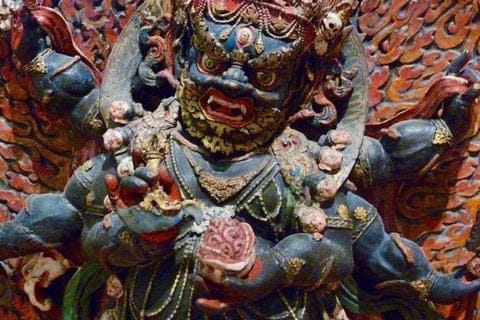Discover the Spiritual Meaning of the Skull
Have you ever wondered about the spiritual significance of skulls? Today, I will try to answer this question in the best possible way by taking examples from many different cultures to explain what the skulls represent for each of them.
Today and especially since antiquity, the symbol of the skull has been the object of common use among several groups of people. Pirates, Orthodox monasteries, pilots, rockers, Goths, SS, hussars, emo ... and many other groups of people have made use of the skull in their symbolism.
Used as a symbol of protection and a sign of victory, the skull is viewed by bikers and soldiers as a symbol that protects against death. For hackers, the skull symbol is used for the purpose of reforming legislation in the field of patents, intellectual property and copyright.
In ancient Rome, the symbol of the skull with bones is a sign of victory over death. Indeed, the symbol of the skull was used by the soldiers in the victorious triumphant processions. In addition, they always accompanied it with a Latin phrase which has become a slogan these days: "Memento mori", "Never forget that you are a mortal".
So, for many cultures the skull has different meanings, what particularly concerns us through this article is knowing the spiritual meaning of the skull.
To begin with, let's first discover the history of the symbolism of the skull.

Symbolic history of the skull
The skull is a common symbol in world culture. It is a mark of human mortality.
It is also considered to be the seat of the soul and human life and has been endowed with unusual ritual value since ancient times.
Among the Celts, the skull was considered a repository of sacred power that immunizes a person from the forces of evil and gives him health and prosperity.
The skull is also a symbol of utmost importance among Hindu hermits. Indeed, for them, it is the sign of renouncing the world of mortals.
In addition, among the Taoists, the immortals are often represented with a unusually overgrown skull - a sign that they have accumulated an enormous amount of Yang energy in their brain during their lifetime.
The well-known saying that a person's future is marked on his forehead is associated among Muslims with the seams of the bones of the skull, the curvatures of which resemble letters.
The skull is included in the main set of death symbols. It is an attribute of the images of many Christian saints and apostles, such as Saint Magdalena, the Apostle Paul and Saint Francis of Assisi.
In addition, often represented with a skull, hermits symbolize their thoughts on death through it.
Some icons with a crucifix are depicted with a skull on the base and commemorate the death of Jesus on the cross.
According to one of the legends, this cross is on Adam's bones, and due to the fact that the Savior was crucified on it, everyone should inherit eternal life.
For example, several witch legends have used the human skull in various rituals to predict the future.
The teraphim were first cited in the Bble with reference to Rachel. She takes it from the homeland of her father Laban, the Aramaic in Mesopotamia (Gen. 31:19), from which it is generally concluded that the cult of the teraphim came from the Aramaic to the Israelites. According to the Bible, Rachel did this to prevent her father from guessing her husband Jacob's intentions.
Since ancient times, the skull has been a symbol of death and the inherent fragility of all living beings. The human skull, both individually and in complex compositions, is one of the most popular artistic subjects.

Spiritual significance of the skull in Christianity
The skull with the crossbones underneath is known in some traditional cultures as "Adam's head" and has an ancient Christian origin.
Legend has it that Adam's ashes rested on Golgotha, where the crucifixion of Christ took place. According to Orthodox belief, the blood of Christ washed the skull of Adam from sinful filth on his face by the providence of God and all mankind, thus giving hope of salvation.
Thus the head of Adam carries a deeply symbolic meaning of liberation from spiritual death and redemption in the traditional Christian sense.
The image of the skull can be seen on many versions of the crucifixion or the cross, such as in the Orthodox monastery scheme.
Other details
When looking at Christian art, it is very common to see skulls next to the saint. In some cases, the saint holds the skull in his hands and looks into his hollow eyes. Why is this? Isn't it a bit surprising?
Skulls are depicted in portraits of saints to underline their wisdom and constant awareness of their own mortality. All the time he thinks about death, forcing him to try with all his strength to reach perfection.
Over the centuries, the Church and many saints have used the Latin expression "memento mori" ("Remember, you must die") to refer to this spiritual practice. It is a simple realization that "You are dust and you will become dust again!" As we are often told. This phrase reminds us that our earthly life is very short and that we know neither the day nor the hour when Christ will come to call us.
Some saints like St. Gerard put the skull on their table. Father John Bartunek said, "When Pope Alexander VIII was elected Pope, he asked the great baroque artist Bernini to carve a small marble coffin. He put it on the table to remind him that one day he will die and give an account to the Lord of how he lived his life as Pope. "
As much as we want to run away from it, each one of us is exposed to certain death.
We are all going to die. The saints constantly remember this fact and symbolize it through the skull.
Thinking about his death is very important, it brings enormous spiritual benefits. If we do not have a healthy fear of death, we will forget our responsibilities as Christians here on earth. And this is what the skull reminds us of in Christianity.

Spiritual Meaning of the Skull in Hinduism and Buddhism
Both religions were aware of life and death and used skulls in the images and artwork of the deities. Symbolically, skulls are so significant that they were persecuted until the beginning of Hindu culture - more than 5,000 decades ago.
In India, skulls have played a very important role in religious beliefs. Skulls were often adorned with ancient gods and goddesses such as necklaces or armbands that showed their powers to defeat death. For example Nataraja, a known personification of Shiva, a cosmic dance for a creation and a necklace of skulls adorning it. A garland of skulls around her neck embodies her as the time and death of all living beings. So Hindu - natural and normal course of life; everything goes round in circles. Both life and death participate in the cosmic drama, and they are embraced rather than resisted.
What about Buddhism?
Since the representation of skulls in Hinduism is rather simplistic, Buddhism has evolved it further with unique approaches. As in Hinduism, skulls are usually represented as chains of jewels around the deity. However, instead of representing loss or death, it presents the Buddhist concept of emptiness. However, instead of depicting death or loss, it presents the Buddhist concept of nullity. In Buddhism, the notion of emptiness is seen as a dimension of the universe.
This means that the phenomena we experience are not contained in themselves; on the contrary, we understand what we experience. Basically, it means that all events are neutral, but we prefer to hit them in our head. The four canines of the skull are represented as the section symbols of the four mar. In Tibetan iconography, single skulls have different shapes and functions.
For example: a skull lamp that burns human fat like a wick with its tongue would be called a symbol of purification. The body (skull) is purified by fire, as is the language (tongue) and the spirit (fat). This is an example of how to leave the cremation process behind. Rather dark, but goes straight to the Goal : Life is short and fragile.
Now that we have understood the spiritual meaning of the skull, let's try to understand what the tattoo of a skull represents for the one who wears it.

What is the meaning of a skull tattooed on the body ?
A skull tattoo on the skin symbolizes that you accept this fatal outcome which is the end of all things. It actually shows that you are enjoying your life to the best of your ability and that you are preparing to accept the arrival of the last day accordingly.
Some exaggerations are committed during a skull tattoo in order to reveal the personality and desires of the wearer.
Indeed, it is a means of expression that says a lot about a person's state of mind and therefore about his personality.
Examples of skull tattoos
There is no lack of ideas for skull tattoos, and if you have already thought about this motif, you will find the best way to express it, whether you are a man or a woman.
For a more feminine approach, we think of an association between a skull and a flower such as a rose, solo or in a bouquet, or a butterfly, to better show the continuous balance between life and death but also the faculty of renewal that everyone possesses. Very trendy, the Mexican skull, or calavera, emblem of the Day of the Dead celebrated in Mexico and the Southwestern United States, will appeal to women and men alike with its bright colors and old school motifs. You can also choose this pattern for a couple tattoo, with a skull adorned with rather feminine elements such as long hair and another more masculine one with a hat for example.
You can also personify this skull of death by adorning it with an Indian headdress to honor the spiritual culture that captivates you - but beware of unwelcome cultural appropriations.
Other options : a very realistic version, in trompe-l'oeil and without colors, or an ultra graphic tribal skull tattoo or a more artistic watercolor style, depending on the style you are particularly fond of.
You are free to add other designs to further enrich the meaning of your skull tattoo, such as a clock or watch, which will accentuate the symbol of the passing of time.
And who says you have to limit yourself to a human skull? Animal skull tattoos are becoming more and more popular, like a buffalo, bull or eagle skull for example, which will highlight their strength and power beyond death.
Conclusion
As you will certainly have already noticed through this article, the spiritual significance of the skull depends on the belief of each people. Thus, there are a multitude of meanings throughout the world.
Moreover, although so diverse, the myths around the skull always refer to either life or death.
For the majority of beliefs, wearing jewelry adorned with skulls can be a source of happiness, remembrance, unhappiness, power, vanity or even victory.
Whatever your beliefs, we invite you to discover more about the spiritual meaning of the skull through our articles.
On the other hand, if you wish to understand more about the meaning of skull tattoos and their usefulness, we also invite you to click here to learn more.
Do you have a question or suggestion ? Feel free to leave it in the comments. You can also contact us for more information on the spiritual meaning of the skull.


What does it mean when you buy a shoe and find skull design on it
Leave a comment